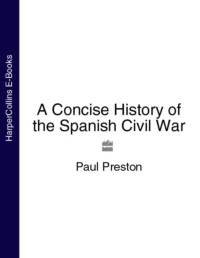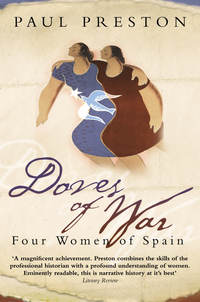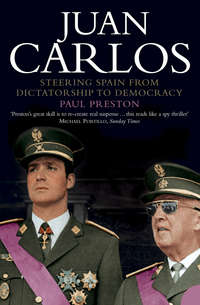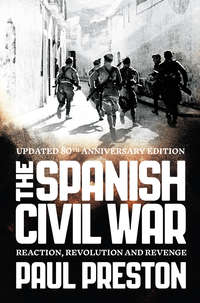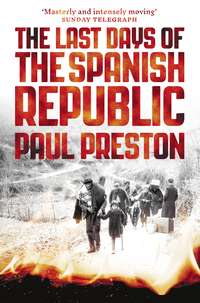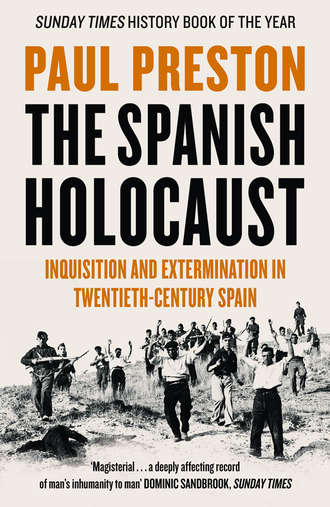
Полная версия
The Spanish Holocaust: Inquisition and Extermination in Twentieth-Century Spain
The government tried to have Reyes buried discreetly but the head of his unit, Lieutenant Colonel Florentino González Vallés, turned the funeral into a massive anti-Republican demonstration. Fernando Primo de Rivera, José Antonio’s brother, met representatives of the UME to discuss the role of Falangists and was told that they were expected to carry guns. Flouting government orders to the contrary, González Vallés, himself a Falangist sympathizer, ordered, in an anti-Republican gesture, that the funeral procession should follow the same route as the 14 April military parade. Despite this illegality, Gil Robles and Calvo Sotelo led the cortège. As it came down the Castellana, several shots were fired at the procession. It is not known if the culprits were leftists or right-wing agents provocateurs. When the Falangists tried to turn the procession into an attack on the Cortes, there was a clash with Assault Guards in which Andrés Sáenz de Heredia, a cousin of José Antonio, was killed. Thereafter, the commander of the Guards, Lieutenant José del Castillo Sáenz de Tejada, received death threats.75 The UME saw the events of 16 April as a boost for recruitment. Prieto commented: ‘Yesterday, it was shown that fascism has taken hold really strongly in our military organizations.’76
Disorder was certainly on the increase during the spring of 1936, but its scale was greatly inflated by the right-wing press and in the parliamentary speeches of Gil Robles and Calvo Sotelo, which placed the blame exclusively on the left. However, only two groups stood to benefit, even in theory, from the proliferation of indiscriminate lawlessness – the extreme left of the anarchist movement and the ‘catastrophist’ right who backed military conspiracy. The Popular Front tactic imposed by Moscow meant that Communists had no plans to undermine public order and seize power. In the Socialist Party, both El Socialista, the newspaper of the Prieto wing, and Claridad, the mouthpiece of Largo Caballero, warned their readers to ignore rightist provocation.77 None of the Popular Front parties had any need to provoke violence in order to take power. The creation of an atmosphere of turmoil and disorder could, on the other hand, justify the use of force to establish a dictatorship of the right. It is difficult to distinguish between provocation and reprisal in street fights between Communists or Socialists and Falangists or members of Gil Robles’s youth movement, the JAP. However, it is noteworthy that José Antonio’s close friend Felipe Ximénez de Sandoval boasted that, in the violence following Reyes’s funeral procession, ‘the mortuary welcomed, for every one of ours, ten of theirs’.78
Significantly, wealthy conservatives who had previously financed Gil Robles to defend their interests were now switching funds to the Falange and the scab union, the Sindicatos Libres. In March, ABC had opened a subscription for a hitherto unknown Federación Española de Trabajadores, behind which could be discerned Ramón Sales, the self-styled fascist agent provocateur who had become famous in the political gangsterism of 1919–23. By late April the fund had reached 350,000 pesetas, donated by aristocrats, landowners, industrialists and many anonymous ‘fascists’ and Falangists. Since the money was never used for trade union purposes and a substantial number of those arrested for acts of violence were members of the Sindicatos Libres, the left had no doubts that this was a fund to finance agents provocateurs. Professional gunmen were being hired by the right and their operations were designed to provoke the widest repercussions.79
The attacks on Jiménez de Asúa and Largo Caballero were clearly among those aimed at provoking reprisals. The most successful operation of this kind was carried out in Granada on 9–10 March. A squad of Falangist gunmen fired on a group of workers and their families, wounding many women and children. The local CNT, the UGT, the Partido Comunista de España (PCE) and the Partido Sindicalista united in calling a general strike in the course of which there was considerable violence. Two churches and the offices of both the Falange and Acción Popular were set on fire, and the ACNP newspaper, Ideal, was destroyed. Throughout the day, Falangist snipers fired from rooftops on left-wing demonstrators and also on firemen to stop them controlling the fires. In Granada and elsewhere, incidents were often caused by strangers who disappeared as quickly as they had appeared. When the military rebels took power at the beginning of the Civil War, some of the most radical anarchists and Communists in Granada revealed themselves as Falangist agents provocateurs. Throughout Spain, leftist municipal authorities worked hard to maintain order. They were not helped by the fact that conservative members of the judiciary sympathized with Falangist activities. Judges who did take a strong line against rightist gunmen were, in their turn, selected as targets.80
On 15 April, when Azaña presented his moderate programme of government to the Cortes, Calvo Sotelo declared that any cabinet that relied on PSOE votes was effectively under Russian dominance. Less stridently, Gil Robles produced a masterpiece of hypocrisy. He patronizingly recognized Azaña’s good intentions and denied that the conflictive situation in the countryside owed anything to CEDA policies. Forgetting the humiliation to which Giménez Fernández had been subjected, he claimed that his party was committed to the elimination of social injustice and to the equitable redistribution of wealth. He went on to endorse Calvo Sotelo’s claim that the government was impotent before a wave of disorder caused entirely by the left. Blaming the violence of agents provocateurs on governmental weakness, he said that his followers were already taking up arms in self-defence. He declared that he would soon have to tell them to expect nothing from legality and to join parties that offered them ‘the lure of revenge’. In apocalyptic terms, he issued a dire warning: ‘Half the nation will not resign itself to die. If it cannot defend itself by one path, it will defend itself by another … When civil war breaks out in Spain, let it be known that the weapons have been loaded by the negligence of a government which has not been able to fulfil its duty towards groups which have stayed within the strictest legality.’ He ended with a resounding battle cry: ‘It is better to know how to die in the street than to be trampled on as a coward.’
Gil Robles was effectively threatening war if the Popular Front did not drop its commitment to thorough reform of the social and economic structure. Because parliamentary speeches could not be censored, Gil Robles and Calvo Sotelo larded theirs with exaggerations of disorder. They knew that, reported in full in the press, their predictions of doom would generate an atmosphere of terror among sectors of the middle and upper classes, who would look to the army for salvation. Gil Robles’s remarks in the Cortes of 15 April and his assiduous attendance at the funerals of Falangist gunmen projected the impression that political violence was the exclusive responsibility of the left. Behind his rhetoric of concern for public order, the CEDA was organizing motorized machine-gun assault groups and, as the spring wore on, ever more rightist youths arrested for acts of violence were members of the Juventud de Acción Popular.81
Gil Robles admitted in his memoirs that the principal function of the CEDA was to make propaganda in parliament and to act as a shield for more violent groups. He quoted approvingly a comment that the perpetrators of right-wing terrorism in the spring of 1936 were ‘of the highest nobility and spiritual quality’. In a newpaper interview, he expressed approval of those who left the CEDA ‘to take the path of violence, believing it to be the way to solve national problems’.82 Almost immediately after the elections, the majority of one of key sections of the CEDA, the Derecha Regional Valenciana, had rejected the moderation of their leader, Luis Lucia, in favour of direct action. Under the leadership of the party’s secretary general, José María Costa Serrano, the DRV was collecting arms and organizing a clandestine militia. Links were established with the local Falange, Renovación Española and the Unión Militar Española. The DRV’s youth section drilled and held shooting practice. Throughout the spring, at least 15,000 members of JAP joined the Falange. Nothing was done to dissuade them and no efforts were made to recruit replacements. Many of those remaining with the CEDA were in active contact with groups committed to violence. And, when the war broke out, thousands of CEDA members joined the Carlists.83
As confrontation in the countryside increased, fears of military conspiracy abounded. On 1 May, the moderate Socialist Indalecio Prieto laid out the problem in a speech at Cuenca, where there was a by-election. He went to Cuenca ‘worried about an imminent fascist uprising about which I had been making warnings to no avail other than to bring upon myself abuse and contempt’. It was thought prudent for him to have an armed escort provided by a group of the Socialist Youth known as the Motorizada. On the eve of his arrival, there had been fighting between local leftists and rightists and ashes were still blowing about from the burning of the casino, the local landowners’ club.84 He underlined the uncertainty provoked by disorder and the attendant dangers of a military coup. In a passionately patriotic speech, he laid out a plan for social justice based on well-planned economic growth to be implemented by a strong government. He denounced right-wing provocation and left-wing agitation – ‘what no nation can sustain is the attrition of its government and of its own economic vitality while being forced to live with unease, nerves and anxiety’.85
An opportunity to strengthen the government arose in early May with the impeachment of Alcalá Zamora and his replacement as President by Manuel Azaña. It was widely hoped that a combination of a strong President and an equally strong Prime Minister could defend the Republic against military subversion. However, when Azaña asked him to form a government, Prieto made the tactical error of twice consulting the PSOE parliamentary group of which Largo Caballero was president. At meetings on 11 and 12 May, Largo Caballero and his followers opposed him and he capitulated quietly. Despite their opposition, Prieto could have formed a government with the support of the Republican parties and about a third of PSOE deputies. However, he was not prepared to split the PSOE.86
By blocking the plan for a Prieto-led government, Largo Caballero had effectively destroyed the last chance of avoiding civil war. A powerful argument in favour of a coup used within the officer corps was that Largo Caballero, once in power, would dissolve the army. Prieto realized, as his rival apparently did not, that attempts at full-scale revolutionary social change would drive the middle classes to fascism and armed counter-revolution. Instead, Prieto, ever the pragmatist, was convinced that the answer was to restore order and accelerate reform. He had plans to remove unreliable military commanders, to reduce the power of the Civil Guard, to appoint a trusted officer as Director General of Security and to disarm the fascist terror squads.87 Largo Caballero prevented this and ensured that the strongest party of the Popular Front could not participate actively in using the apparatus of the state to defend the Republic. Azaña turned to his fellow Left Republican Santiago Casares Quiroga, who lacked the stature to deal with the problems he was called upon to solve. Prieto wrote later, ‘My role was thus reduced to constantly issuing warnings about the danger, and trying to ensure that, within our camp, naive and blind obstinacy, typical of a lamentable revolutionary infantilism, did not go on creating an atmosphere favourable to fascism because that was all that absurd acts of disorder brought about.’88
On 19 May, Casares Quiroga, Azaña’s successor as Prime Minister, presented his programme to the Cortes. Gil Robles responded with a virtuoso display of ambiguity. As on 15 April, an apparent appeal for moderation was in reality a justification of violence. Without mentioning names, he dwelled gloatingly on Azaña’s failure to get a broadly based Popular Front government under Prieto, stating that the Republican government was ‘reduced to the sad role, in relation to those groups [pointing to the Socialist benches], of being today the servant, tomorrow the victim’. Regarding Casares Quiroga’s declared hostility to fascism, he pointed out that disorder made fascist solutions relevant. While criticizing fascism in theory because of its foreign origins and its elements of state socialism, he justified the violence of those denounced as fascists, saying that there was no other way for them to defend their interests. He had nothing to say about how the present political disorder had been incited by the repressive and vindictive policies carried out by Radical–CEDA cabinets. Declaring that democracy was dead, he praised the trend to fascism as growing out of ‘a sense of patriotism, perhaps badly focused but profoundly hurt to see that the rhythm of politics is dictated not by great national interests but by you [turning to the Socialist deputies] with orders from Moscow’. It was an endorsement of the flight of the JAP masses into the Falange. Ending with a provocative challenge to Largo Caballero’s followers, he made a sarcastic reference to ‘you ferocious revolutionaries who do nothing but talk’.89
Gil Robles’s denunciations of the breakdown of public order were seen on the left as a hypocritical attempt to discredit the government and justify a military coup. Those speeches also fed on the Falangist strategy of tension, directed from prison by José Antonio Primo de Rivera. After his arrest, his party went underground and the bloody cycle of provocation and reprisal was intensified dramatically. On 7 May, ripples of the Reyes funeral three weeks earlier could be seen in the murder, by a joint UME–Falangist squad, of Captain Carlos Faraudo, the Republican engineers officer who drilled the Socialist militias. The following day, there was a failed attempt on the life of the conservative Republican ex-Minister José María Álvarez Mendizábal. José Antonio told his friend Felipe Ximénez de Sandoval: ‘I don’t want any more Falangists in jail. I will use all my authority as Jefe Nacional [national leader] of the Falange to expel anyone who comes here without a good reason, such as having killed Azaña or Largo Caballero.’ The consequent disorder was the basis of the appeals of Gil Robles and Calvo Sotelo for military intervention.90
Within the government apparatus, the man most concerned by the links between military conspiracy and Falangist violence was the Director General of Security, José Alonso Mallol. Since being appointed in February, Alonso Mallol had worked tirelessly to combat Falangist terrorism and to monitor the activities of hostile officers. One of his innovations was to place telephone taps on the houses and the barracks where the coup was being hatched. José Antonio’s correspondence with the conspirators was also intercepted. By May, Alonso Mallol was able to give President Azaña and the Prime Minister Casares Quiroga a list of more than five hundred conspirators whom he believed should be arrested immediately. Fearful of the possible reactions, Azaña and Casares failed to act and the coup went ahead.91
In fact, as José Antonio boasted to the monarchist Antonio Goicoechea on 20 May 1936, being in prison was no impediment to directing the Falange’s role in the preparations for civil war. From his cell, he liaised with Carlists and with Renovación Española.92 He had already met General Mola on 8 March to offer the services of the Falange. Also in early March, José Antonio’s friend Ramón Serrano Suñer had put him in touch with other senior military figures including Yagüe, Mola’s key to the participation of the Moroccan Army.93 The role of the Falange would be to carry out acts of terrorism to provoke left-wing reprisals, the two things combining to justify right-wing jeremiads about disorder. From prison, José Antonio issued on 20 May the first of three clandestine leaflets with the title No Importa. Boletín de los Días de Persecución (No Matter. Bulletin of the Days of Persecution). Urging his followers to intensify their attacks on leftists, he wrote on 6 June, ‘Tomorrow, when brighter days dawn, the Falange will receive the laurels earned by being first in this holy crusade of violence.’ In the same issue, there was a call for the assassinations of the judge who had sent him to prison and of the Socialist parliamentary deputy for Cáceres, Luis Romero Solano, for his part in the arrest of José Luna, the Falange leader in Extremadura.94
The principal orchestrator of the coup, General Mola, had been posted to Navarre in March. The government hoped thereby to neutralize him but, confident of the most influential officers in Morocco and of his police network, he still held the key strands of the rebellion. It was assumed that Mola would have few dealings with the deeply reactionary local Carlists. In fact, within three days of his arrival in Pamplona on 14 March, local officers introduced him to B. Félix Maíz, a thirty-six-year-old local businessman who was to be his liaison with the Carlists. Discovering a shared enthusiasm for The Protocols of the Elders of Zion, they hit it off immediately. To Maíz’s delight, Mola, who was still receiving paranoiac anti-Communist reports from the White Russians in Paris, told him that ‘we confront an enemy that is not Spanish’. Maíz, who took The Protocols as genuine, believed that a war to the death was imminent between Christians and the stooges of the Jews ‘the great beast – tightly knit hordes emerging from the swamp of evil’. His view of the political situation was even more disturbing: ‘all over Spain, there are gangs of creatures injected with rabies who are seeking Christian flesh in which to sink their teeth’.95
The fantasies of Maíz were merely an extreme version of a carefully prepared fiction intended to justify the military coup and the subsequent repression. ‘Secret documents’ were concocted to ‘prove’ that a Soviet take-over in Spain was imminent. A kind of Spanish equivalent to The Protocols of the Elders of Zion, these ‘documents’ were intended to generate fear and indignation, not least because they contained blacklists of right-wingers intended to be murdered as soon as the alleged Communist take-over was completed.96 Such inventions presented a military coup as a patriotic act to save Spain from the assault masterminded by the dark hand of Judaism. With such a view of the enemy, it was but a short step to Mola’s first secret instructions to his fellow conspirators, issued in April. He wrote, ‘It has to be borne in mind that the action has to be violent in the extreme so as to subdue as soon as possible the enemy which is strong and well organized. It goes without saying that all leaders of political parties, societies and trade unions not part of the movement will be imprisoned and exemplary punishment carried out on them in order to choke off any rebellion or strikes.’97 Mola, as a hardened Africanista, placed a high value on the value of terror in paralysing opponents. However, it was not just a question of gaining power but also the first step to ‘purifying’ Spain of the noxious elements of the left.
José Antonio was transferred to the prison in Alicante on the night of 5 June, and he immediately sent an emissary to Pamplona to reassure Mola that he remained committed to the coup and to offer four thousand Falangists as a shock force for the first days of the uprising.98 In a further testimony to the links between the military and street violence, the monarchist politician Antonio Goicoechea wrote on 14 June to the Italian government on behalf of the Falange, Renovación Española and the Comunión Tradicionalista to request funding for terrorist squads. Commenting that the military coup was well advanced, he wrote of ‘the unavoidable need to organize the atmosphere of violence’.99
Despite mounting rural violence, the FNTT managed to maintain the discipline of its members, even after a bloody incident at the end of May near the town of Yeste in the south of Albacete. The fraudulent enclosure of communal lands by local caciques had condemned the peasants to desperate poverty. Many had lost their livelihood as a result of the construction of a reservoir near by in 1931, which took fertile land out of production and prevented local woodmen transporting timber via the Rivers Tus and Segura. In the spring of 1936, the efforts of the newly restored Republican–Socialist town council to place unemployed workers on estates had met with furious resistance. On 28 May, a group of workers and their families from the hamlet of La Graya cut down trees for charcoal and then began to plough on an estate called La Umbría. Once common land, La Umbría now belonged to the most powerful cacique, Antonio Alfaro. On his instructions, twenty-two Civil Guards arrived.
Most of the villagers fled but six remained. After beating them, the Civil Guards took them to La Graya, where they were further mistreated. At dawn the next day, a crowd of labourers from surrounding hamlets followed as the prisoners were being taken to the nearby town of Yeste to ensure that they would not be shot ‘trying to escape’ (the ley de fugas). The crowd swelled and, as they reached Yeste, it was agreed that the prisoners should be released into the custody of the Mayor. When the crowd pressed forward to greet the prisoners, a Civil Guard panicked and fired a shot. In the ensuing mêlée, a Civil Guard was killed. His companions opened fire on the crowd and then pursued fleeing peasants into the surrounding hills, killing seventeen people, including the deputy Mayor, and wounding many more. Fearing that the Civil Guards would return and burn La Graya, many villagers took refuge in nearby hamlets. Fifty FNTT members were arrested, including the Socialist Mayor of Yeste.100 Yeste and other clashes could have led to bloodshed on a large scale. However, the FNTT leadership restrained the rank and file, urging them to put their faith in the government’s accelerated agrarian reform. Faced with the new determination of the Popular Front, the large landowners began to look to the military for their protection.
A similar scale of belligerence from the landowners was revealed in Badajoz when the Civil Governor took the extraordinary step on 20 May of closing the provincial headquarters of the Association of Rural Estate-Owners which was co-ordinating efforts to sabotage the harvest and to mount a lock-out of unionized labour.101 It was to no avail; many landowners preferred to let the cereal harvest rot in order to impose discipline on the workers. To their fury, the Civil Governor decreed that the workers should bring in the harvest and keep part of the crop in lieu of wages.102 In the province of Cáceres, a systematic policy of provocation was carried out by well-armed Falangists. Among the rightists arrested there for public order offences in the spring and summer of 1936 were several members of the JAP.103
It was a short step from the exasperation of starving labourers to disorder. The scale of hunger in rural Spain in 1936 is almost unimaginable today. On 21 April, the Civil Governor of Madrid was informed that the only available protein for peasants in the province was lizards and that children were fainting from malnutrition in their schools. The Civil Governor of Ciudad Real reported that in the south of the province peasants were living off boiled weeds. In Quintanar de la Orden in Toledo, men and women were found lying in the streets having collapsed from inanition. In many villages, and not only in the south, hunger provoked mass invasions of estates to steal crops or livestock. Attacks on food shops were not uncommon. In Fuente de Cantos in Badajoz, in May 1936, a meeting to discuss local unemployment was addressed by the local Socialist leader. Appalled by the evident distress of the men, women and children of his audience, he called on them to follow him to where there was food for all. He led them to one of the estates of the biggest owner in the area, the Conde de la Corte. The estate was largely given over to the pasture of pigs and sheep. The starving townspeople fell upon the pigs and, after killing them with sticks and knives, returned to Fuente de Cantos, bloodstained and staggering under the weight of the slaughtered pigs. Further to the north of Badajoz, in Quintana de la Serena, day-labourers entered an estate, stealing sheep to feed their families.104


